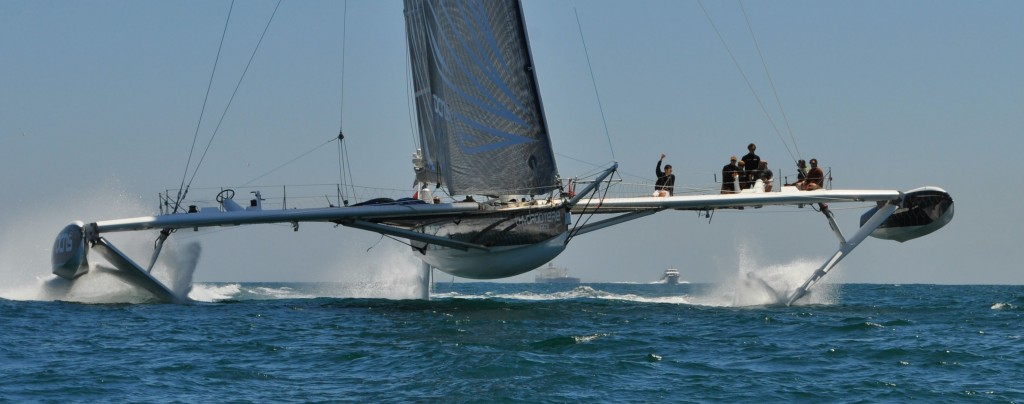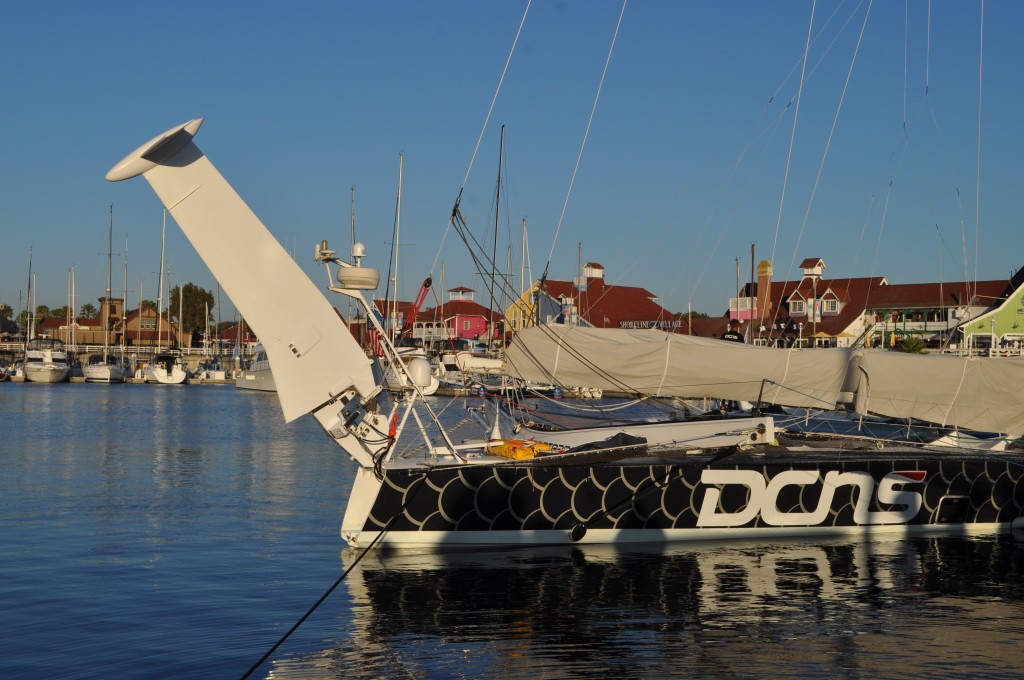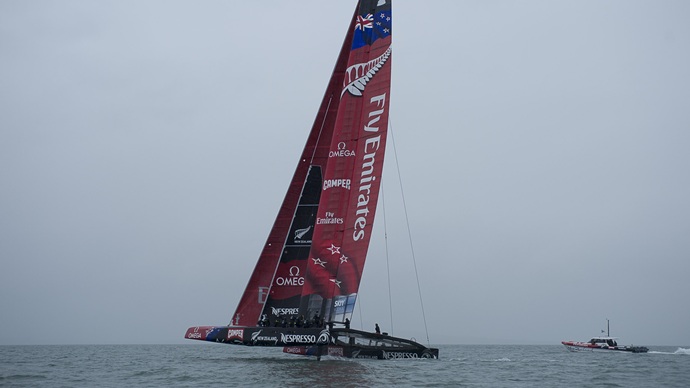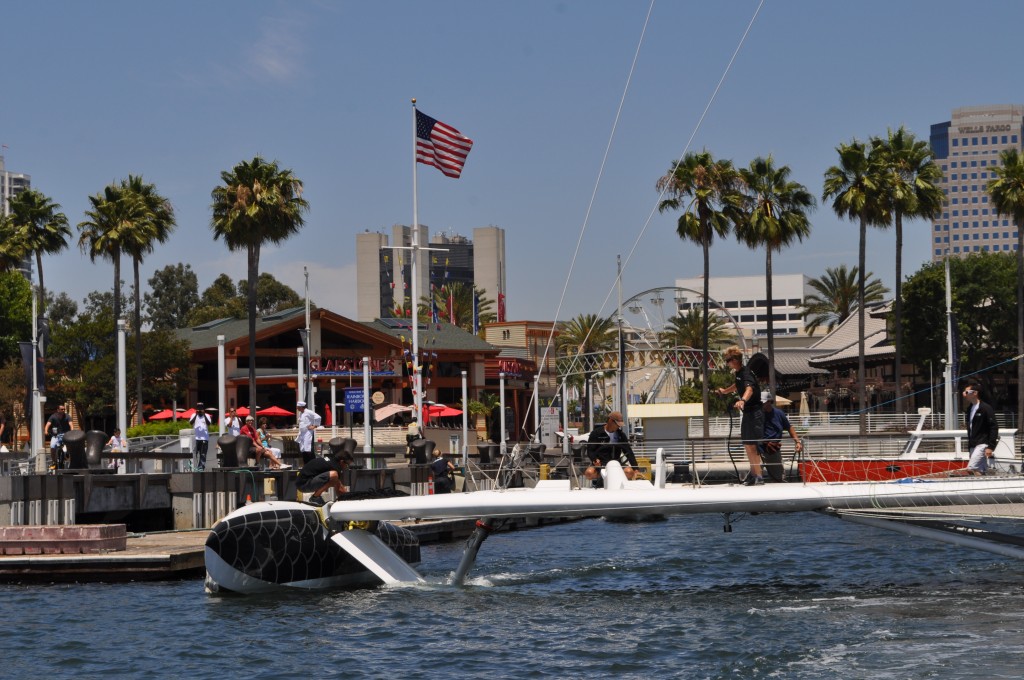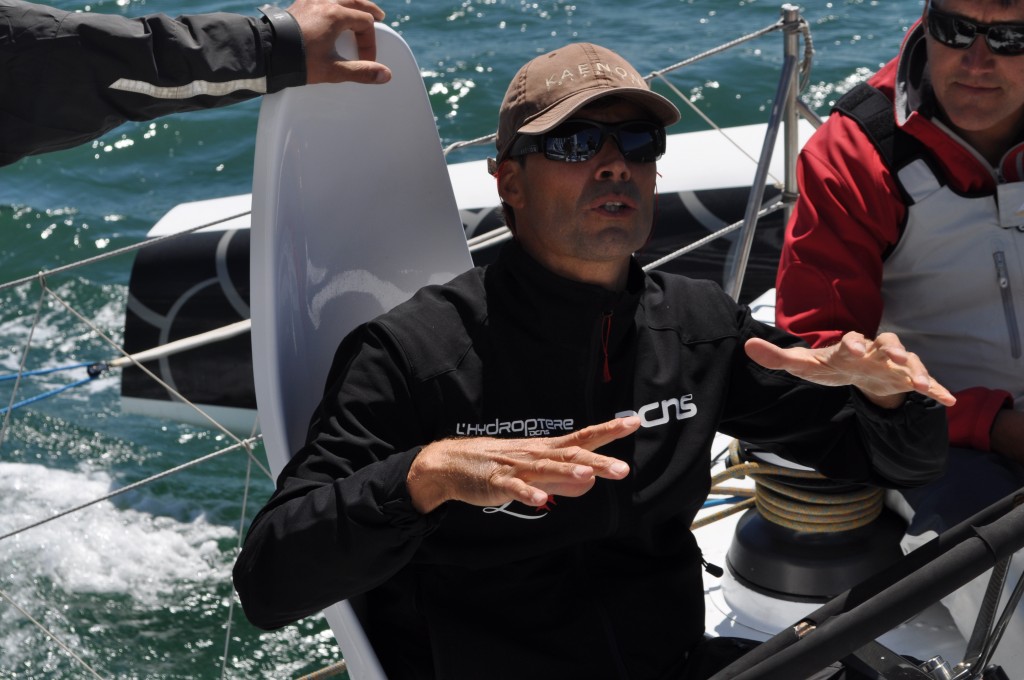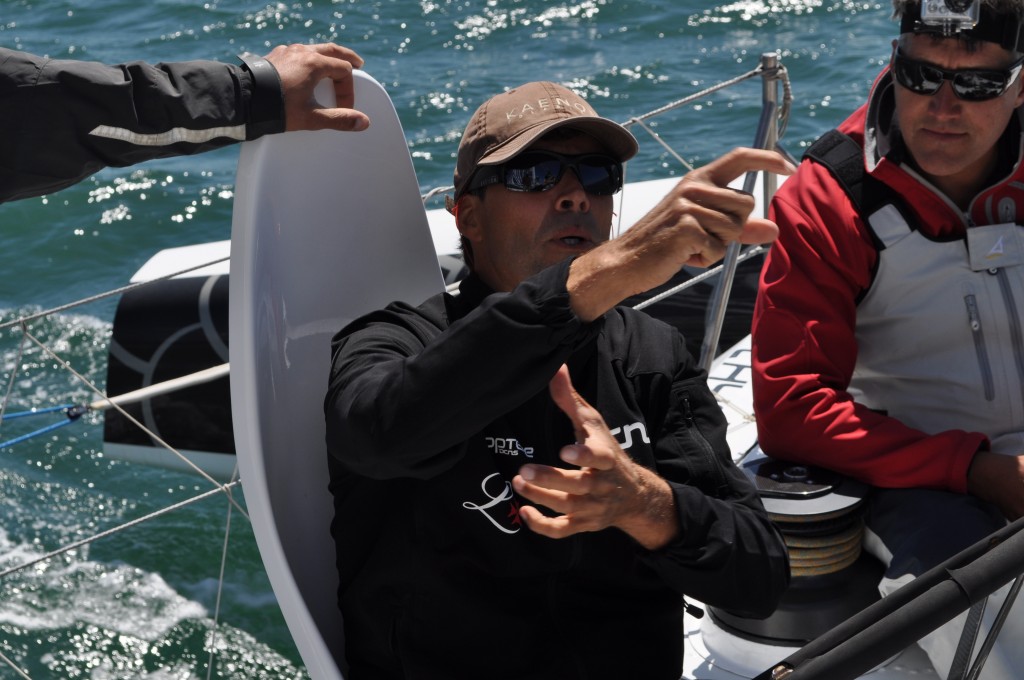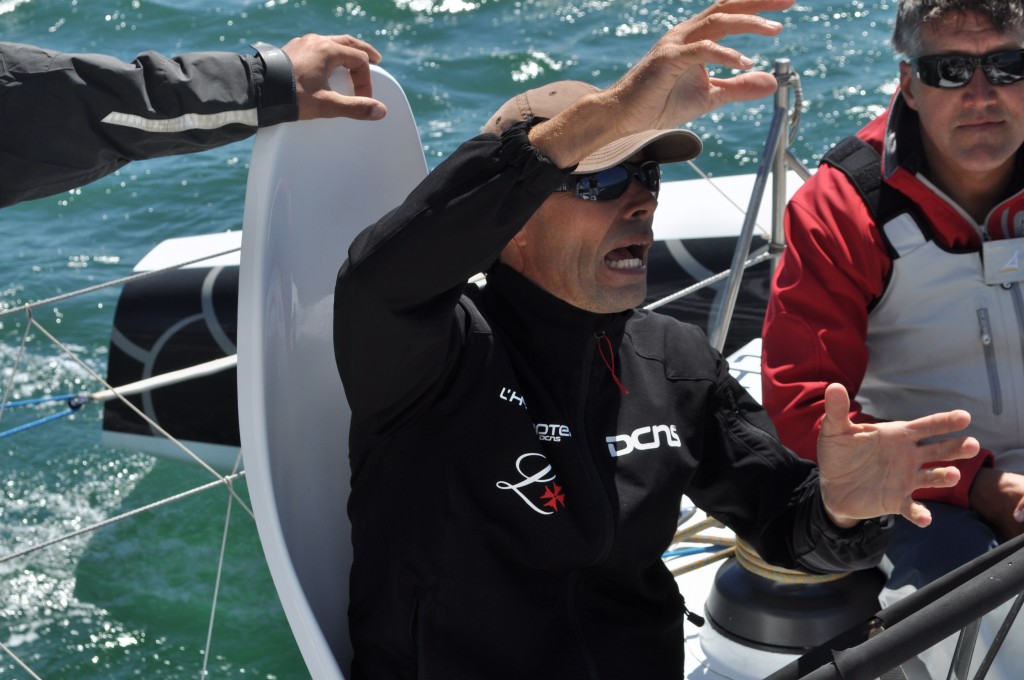The Water Wing, aka l’Hydroptere
When we slowed to 22 knots, it felt like sailing into molasses.
That is the addiction of speed.
And I appreciate it, Jimmy Spithill, that you once showed me 28 knots on an AC45, but the boys on l’Hydroptere let me drive at a boatspeed of 34 knots. Top number for the day, 38 knots in winds in the teens.
To go faster, l’Hydroptere wants more wind and less sail. Too much sail, and the world’s most famous foiling trimaran fights foil with foil for no gain.
A late afternoon round trip to Catalina? Just cruisin’.
Should I, ah, interject here that the only way to see speeds like this in the 2016 Olympics is to stick with the plan for kites? I’m just saying.
And yes, I can report that there is a foot-touch Jesus button (depower depower depower) beside each wheel.
Now and (probably) for a week or more to come, the crew of the fastest sailboat in the world, l’Hydroptere, waits coiled and ready at the dock off Gladstone’s Long Beach for the moment to launch its attempt at a record crossing on the classic Pacific Ocean course, Los Angeles to Honolulu.
Having hooted and hollered at hitting 14’s or 16’s on that course, I stand in awe at the steel balls it takes to aim at the open ocean with l’Hydroptere, a machine that holds the nautical mile record at 50+ knots, with no expectation of hitting 50 on the way to Diamond Head but every expectation (or hope) of being there in three days. She feels very stable at 25, 30, 35 knots. Beyond 45, the boys tell me, “it’s different.”
There are two storylines here.
1) Can Alain Thébault’s lifelong dream-made- manifest translate from 500 meter records, nautical-mile records, and an English Channel record to ocean-crossing records?
2) Is the definitive foil-born multihull soon to be crowded by the new generation of America’s Cup 72-footers?
It’s just possible that Thébault’s guys were a bit shocked to see the pic of Oracle Team USA’s AC45 up on foils, with all that it implies. Remember this from a few weeks ago . . .
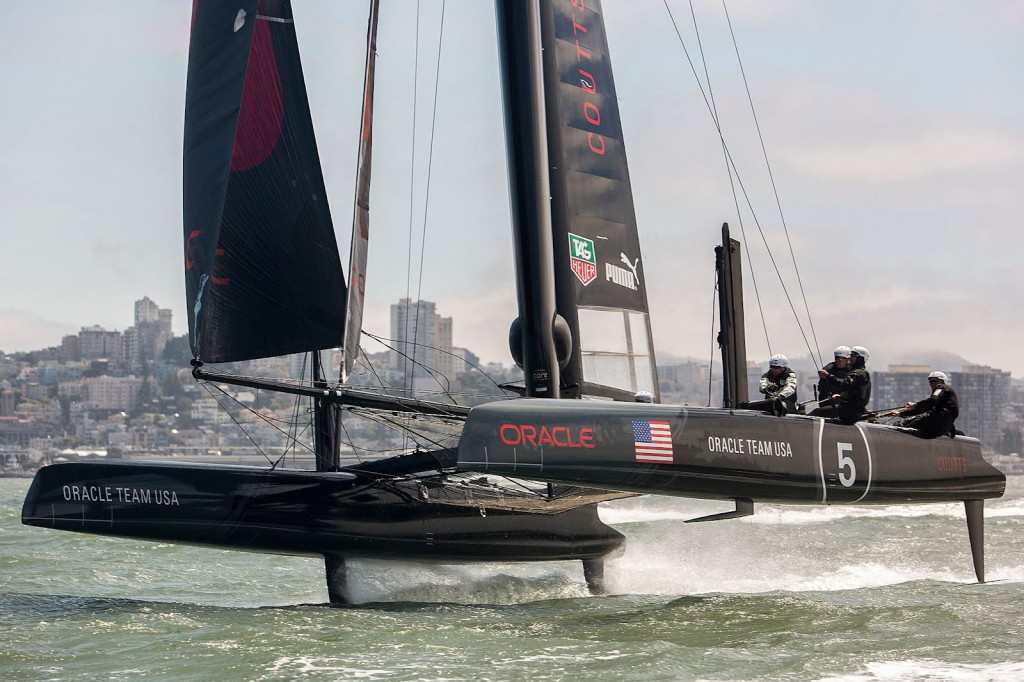 Photo: Guilain Grenier/Oracle Team USA
Photo: Guilain Grenier/Oracle Team USA
Thébault started with model testing circa 1984 in a pond at Versailles, then built a one-third scale model, then the first of four l’Hydroptere iterations, launched in 1994. As for the version now being sailed by Thébault and company . . .
Well, they’ve only pitchpoled this one once, and that was four years ago, so of course it wasn’t worth mentioning, as we took off for Catalina, that they had never previously tested the new, computerized automatic pitch-control system.
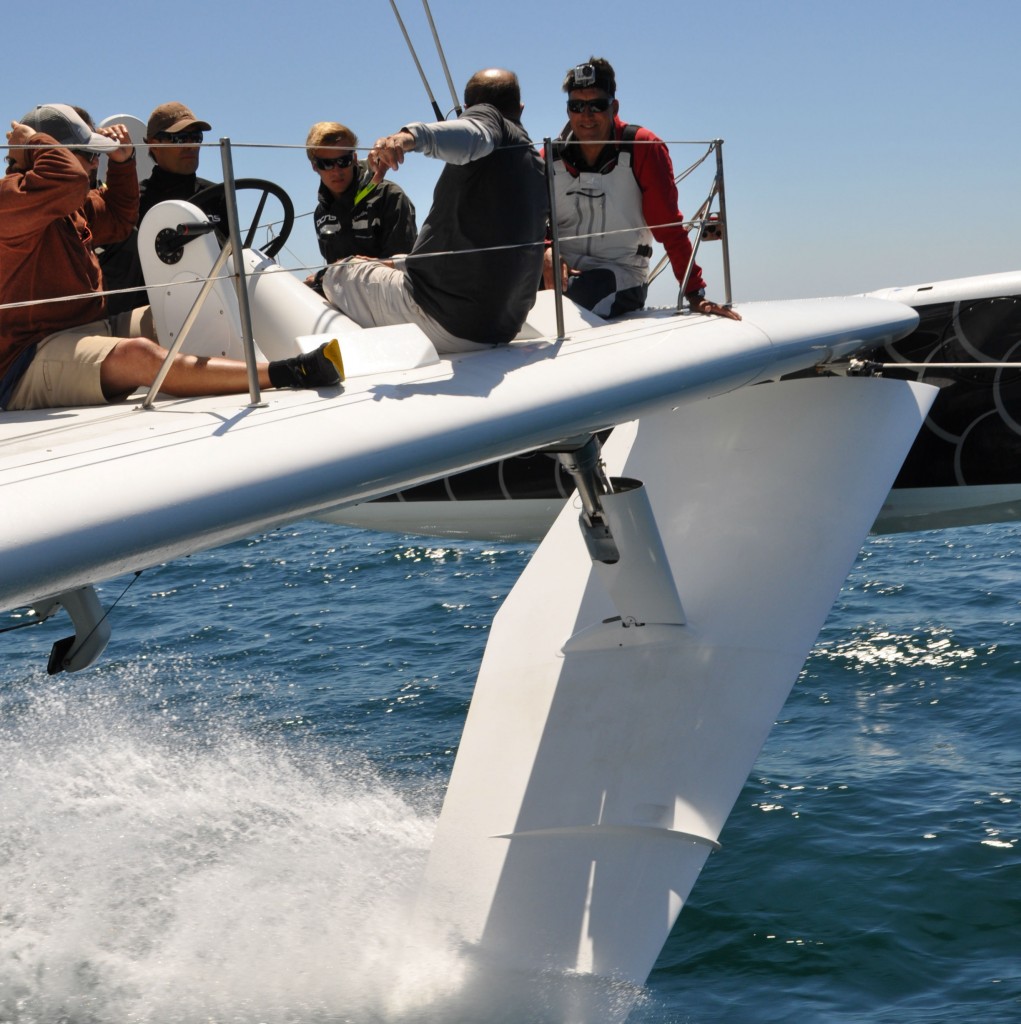 Nothin’ mom, just hangin’ with the fellas. Photo © Kimball Livingston
Nothin’ mom, just hangin’ with the fellas. Photo © Kimball Livingston
Jacques Vincent was our skipper du jour. He’s a veteran of eight circumnavigations and 29 Atlantic crossings, but he gets the sillygrins on l’Hydroptere just like the rest of us. For the record attempt, he’ll be joined by Thébault, of course, and fellow sailing legends Yves Parlier and Jean le Cam, also one guy who is not a legend in sailing, but he has been a champion skiier, and he did win the Paris-Dakar Rally, and he’s pretty handy on the wheel—Luc Alphand.
L’Hydroptere’s pitch-control system depends, predictably, upon winglets on the rudder, which adjusts (the rudder) in-toto. At the dock, the unit tilts up to stay clean and dry . . .
With the auto turned on and the pitch control kicking in, the helm occasionally transmits the odd sensation that someone else is also driving. (While I was driving, that probably was a good thing.) In my reading of the AC72 rule, meanwhile, I find that variable-pitch elements on the rudder, or of the rudder, are not permitted, so the question becomes one of lift with limits. It’s not news that foils are critical to AC72 design—curved foils support as much as 80 percent of the displacement of “conventional” ocean-record sailing multihulls, and it was only for simplicity that straight foils were put into AC45s—and we will be somewhere in the Louis Vuitton Cup, the 2013 Challenger elimination series, before civilian observers know by eyeball what is fast: a curved foil, an S foil, an L-foil or something completely different.
The question in my mind would be, if you go full-foil, how do you control pitch? Moth dinghies famously use trimmable winglets on their rudders to keep things more or less on the level. The foiling AC45 we saw earlier displayed tiny winglets on the rudders that appeared to be fixed, and apparently that works, or it works at least long enough for a pic. Could it work maximally for a full race in an AC72? If I could answer that, I could really make this read worthwhile, eh?
The relevant aspects of the AC72 rule:
8.3 Rudders shall rotate only, and that rotation shall be about a single axis which is within 10 degrees of vertical. This rule does not prohibit the use of self-aligning rudder bearings.
8.4 Rudders shall not translate in any direction.
8.5 Rudders (including rudder stocks) shall not exceed 5.000 m in any direction, measured along a straight line.
8.6 Rudders shall not have components such as trim tabs or moveable winglets, that can be adjusted while racing.
‘Tis a more interesting problem, methinks, than optimizing winglets for V5 ACC boats in ’07. Here’s what we’ve seen so far of the first-launched AC72, Emirates Team New Zealand . . .
THE RIDE
The Gladstone’s RIB is l’Hydroptere’s towboat for its stay in Long Beach. The departure looked like this . . .
Jacques Vincent was skipper du jour, with the assignment to get the boat ready for Thébault and the rest of the sailing team to do a walk-on. Jacques gave us a few fly-bys, then I climbed aboard with Gladstone’s owner, John Sangmeister. Two California sailors were there ahead of us, Peter Heck and Steve Rosenberg, sillygrins already in place, and it takes no time at all to rev this puppy up. Vincent did most of the driving, but he shared with Rosenberg, maker of the sailors’ choice shades, Kaenon, to spread a few more sillygrins . . .
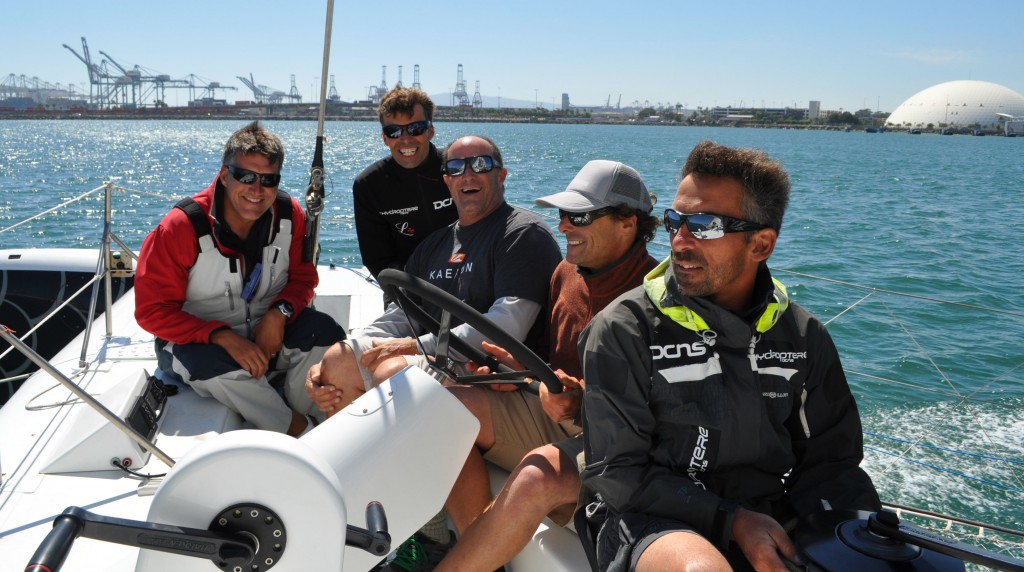 John Sangmeister, Jacques Vincent, Peter Heck, Steve Rosenberg, François Cazala
John Sangmeister, Jacques Vincent, Peter Heck, Steve Rosenberg, François Cazala
And a few more sillygrins as Sangmeister got his turn. John was part of Dennis Conner’s America’s Cup winning crew in Fremantle in 1987 . . .
 Warren Fitzgerald, Sangmeister, Vincent, Cazala
Warren Fitzgerald, Sangmeister, Vincent, Cazala
Now tell us, Jacques, even though it’s been four years, what’s it like to pitchpole this thing? For once, we don’t need audio for the answer . . .
Next: Part II. A bit about the workings of the Ultimate Sillygrins Machine and its, um, elegant accommodations.
Heh. 34 knots—Kimball

